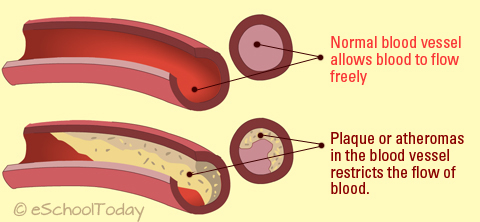 |
Atherosclerosis & Arteriosclerosis
Atherosclerosis, occurs when arteries (vessels carrying oxygen-rich blood to the brain and other body parts) become clogged up by fatty substances (also called plaques or atheromas), such as cholesterol. Plaques or atheromas cause arteries to harden and narrow-up, resulting in restricted blood flow or plaque raptures, which then clots the blood. When this happens, it can block blood flow and result in a stroke and heart attack. Some experts say that Atherosclerosis itself is not the disease, but a risk factor.

Atherosclerosis is commonly confused with Arteriosclerosis. Arteriosclerosis has to do with the walls of the arteries thickening and losing its elasticity. Both may result in the same complications of stroke, heart attack and others.(click to see detailed illustration)

Causes of Atherosclerosis
The causes of artery clogging is one that many experts are still unsure of, but research shows that there are risk factors that make you vulnerable. These include smoking, a high-fat diet, a lack of exercise, being overweight or obese, having either type 1or type 2 diabetes, having high blood pressure (hypertension) or having high cholesterol.
Signs of Atherosclerosis
Some signs of developing Atherosclerosis include:
 Weakness or numbness in your legs Weakness or numbness in your legs
 Having sores on your feet or legs that never heal Having sores on your feet or legs that never heal
 A change in the colour of the skin on your legs A change in the colour of the skin on your legs
 Hair loss on your legs or feet Hair loss on your legs or feet
 Thickening of your toenails Thickening of your toenails
 Erectile dysfunction, also known as impotence (in men) Erectile dysfunction, also known as impotence (in men)
Treatment and Prevention of Atherosclerosis
There is treatment available for Atherosclerosis, and it aims to prevent Atherosclerosis from degenerating into a heart attack. Your doctor will take you through some medications. Additionally, lifestyle changes such as eating a healthier diet and increasing exercise can help you minimize the risks.

|
 |
